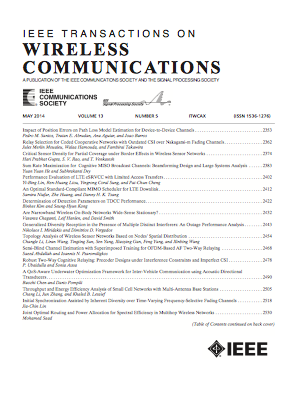STARS Assisted Semi-Grant-Free NOMA Communications
IF 10.7
1区 计算机科学
Q1 ENGINEERING, ELECTRICAL & ELECTRONIC
引用次数: 0
Abstract
This paper investigates the performance of simultaneously transmitting and reflecting surface (STARS) assisted semi-grant-free non-orthogonal multiple access network with randomly distributed users. By deploying STARS, the transmit signals of grant-based user (GBU) and grant-free users (GFUs) can be exquisitely adjusted to reduce interference. We propose a maximum channel scheduling (MCS) protocol that allows a GFU to access GBU’s channel with the assistance of STARS. In particular, the impacts of perfect/imperfect successive interference cancellation (pSIC/ipSIC) on MCS protocol are taken into account. To characterize the performance of STARS aided MCS (STARS-MCS) network, we derive the expressions of outage probability for GBU and GFU with pSIC/ipSIC. By applying convolution theorem and Laplace transform, the asymptotic expressions of outage probability and diversity orders for GBU and GFU are attained. We further design a STARS-based power control (SPC) strategy to eliminate the outage probability error floor and improve the outage performance. Numerical results show that: 1) The performance of STARS-MCS outperforms the existing benchmarks in terms of outage probability and system throughput; 2) The SPC strategy can effectively improve the performance of the STARS-MCS network and eliminate the outage probability error floor at high signal-to-noise ratios; and 3) By adjusting reflection and transmission coefficients of STARS, the outage performance of GBU and GFU can be greatly enhanced.STARS辅助半免费NOMA通信
研究了随机分布用户同时发射和反射面(STARS)辅助半免授非正交多址网络的性能。通过部署STARS,基于授权的用户(GBU)和无授权用户(gfu)的发射信号可以精确地调整,以减少干扰。我们提出了一个最大信道调度(MCS)协议,该协议允许GFU在STARS的帮助下访问GBU的信道。特别地,考虑了完全/不完全连续干扰消除(pSIC/ipSIC)对MCS协议的影响。为了表征STARS-MCS (STARS-MCS)网络的性能,我们推导了基于pSIC/ipSIC的GBU和GFU的中断概率表达式。利用卷积定理和拉普拉斯变换,得到了GBU和GFU的中断概率和分集阶数的渐近表达式。进一步设计了一种基于stars的功率控制策略,消除了停电概率误差层,提高了停电性能。数值结果表明:1)STARS-MCS在中断概率和系统吞吐量方面优于现有基准;2) SPC策略可以有效提高STARS-MCS网络的性能,消除高信噪比下的中断概率误差层;3)通过调整STARS的反射系数和透射系数,可以大大提高GBU和GFU的停机性能。
本文章由计算机程序翻译,如有差异,请以英文原文为准。
求助全文
约1分钟内获得全文
求助全文
来源期刊
CiteScore
18.60
自引率
10.60%
发文量
708
审稿时长
5.6 months
期刊介绍:
The IEEE Transactions on Wireless Communications is a prestigious publication that showcases cutting-edge advancements in wireless communications. It welcomes both theoretical and practical contributions in various areas. The scope of the Transactions encompasses a wide range of topics, including modulation and coding, detection and estimation, propagation and channel characterization, and diversity techniques. The journal also emphasizes the physical and link layer communication aspects of network architectures and protocols.
The journal is open to papers on specific topics or non-traditional topics related to specific application areas. This includes simulation tools and methodologies, orthogonal frequency division multiplexing, MIMO systems, and wireless over optical technologies.
Overall, the IEEE Transactions on Wireless Communications serves as a platform for high-quality manuscripts that push the boundaries of wireless communications and contribute to advancements in the field.

 求助内容:
求助内容: 应助结果提醒方式:
应助结果提醒方式:


